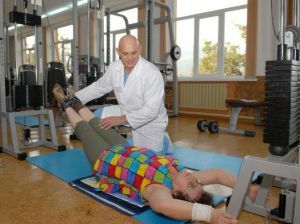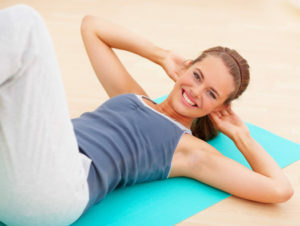 The program of gymnastic exercises, conducted under the guidance of a trained professional, is quite effective method of treating pain in the pathology of intervertebral discs.
The program of gymnastic exercises, conducted under the guidance of a trained professional, is quite effective method of treating pain in the pathology of intervertebral discs.
The complex approach of curative gymnastics usually consists of teaching the patient to correctly move and recruiting certain exercises that help to relax the spasmed muscles and normalize their work, overall strengthening of the muscle corset and helping to keep the spine in a neutral position( directly) during daily activities.
People who suffer from pain caused by a herniated intervertebral disc should avoid performing actions that create excessive stress on the lower back or require sharp "twisting" movements, such as in football, golf, ballet, and lifting weights.
Additional aerobic exercises( with low intensity, for example, walking, exercise bike, swimming) can be started a little earlier than gymnastics, two to three weeks after the start of therapy. Running is not recommended, at least until the pain has disappeared and the back muscles have not grown stronger.
While muscles that make up the back corset are not well trained, exercises that create pressure on the lower back( for example, squats with extra load) should be avoided. It must be constantly remembered that the performance of gymnastic elements should be slow and sparing.
Types of gymnastic exercises with a herniated intervertebral disc.
There are different types and types of physical activity, which find their application for the successful treatment of pain manifestations in hernia of the spine. Stretching exercises are best suited to reduce the symptoms of pain, while strengthening ones - more contribute to the restoration of lost functions( increase mobility).
Exercises, most commonly used for the pathology of disks, can be divided into:
- Low-intensity aerobic exercise .This includes swimming, bicycling and walking, through which the muscles of the abdomen and back are strengthened without undue tension. Especially useful is water gymnastics, since water helps minimize the burden on the spine during exercise.
- Yoga, tai chi, qigong .Various sets of gymnastic exercises, invented in the countries of East Asia, combine physical techniques with meditation, which allows you to achieve a psychophysical balance that effectively prevents recurrence of lumbar pain.
- Stabilizing exercises ( or strength training).This type of gymnastic exercises leads to an increase in the muscular strength of the abdomen and lower back, improving mobility, strength and endurance in general, as well as further increasing flexibility in the joints of the hips and knees.
- Stretching devices .These exercises are most effective in helping to reduce soreness, but the best results, as practice shows, can be achieved with their combination with exercise.
Exercises that strengthen the abdominal muscles
- Torso elevations ( useful to strengthen the weak muscles of the upper abdominal press).To perform them you need to lie on your back, lower limbs bend at the knees, and hands to place on your chest crossed. Raise the upper part of the body fifteen to twenty centimeters from the floor, hold it for 2 to 5 seconds, then slowly lower to the initial position. Exhale on the way up, and inhale on the way down. It is worthwhile to strive to implement the two approaches ten times. If you are concerned about the pain in the neck, hold your hands behind your head for support.
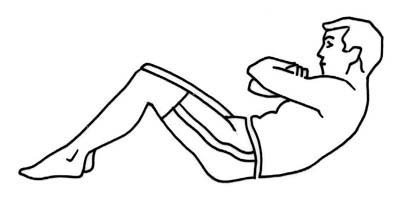
- To strengthen the muscles that make up the lower abdominal press , lie on your back and alternately and slowly raise your straightened legs 30 to 50 centimeters from the floor. Fix them in the top position for ten seconds, then also slowly lower. Strive for two approaches to ten ascents.
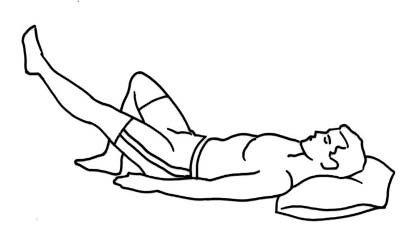
- Lie on your back( as a rule, in a relaxed relaxed state, a gap is formed between the back and the floor).By straining the muscles of the anterior abdominal wall, press the back to the floor so that the gap disappears, stay in this position for eight to ten seconds, return to the starting position. Do the reception 8-10 times.
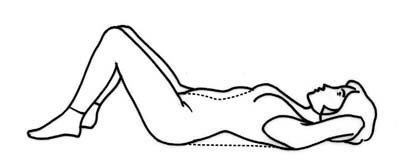
Exercises relaxing the back muscles
- Pelvic lift .Lie on your back, bend your legs well in the knee joints. Tighten the buttocks and stomach so that the lower back is slightly raised above the floor, freeze in this position for a second. Go back to the floor, relax. Try to breathe evenly. Gradually extend the exercise to 5 seconds. Then, set your feet apart a bit further from the body and try again.
- Extension exercise .From the position lying on your stomach with your arms bent at the elbows, slowly raise the upper part of the torso on your elbows, keeping the hips and the pelvis on the floor( Fig. 4).Quit in this position for five seconds and go back to the floor. Gradually increase the stay in the unbent position to thirty seconds. Repeat ten times.
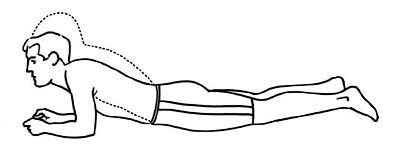
When this exercise seems to be easy for you to accomplish, you can go to a more complex form - climb not to the elbows, but to the fully straightened arms. If you are difficult to lie for one reason or another, a similar exercise can be performed standing, slowly arching your back, arms on the hips. However, it is still preferable to do this lying exercise.
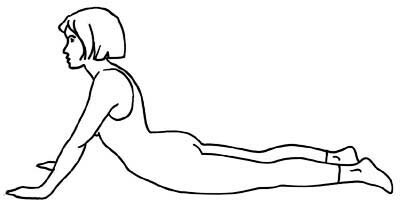

Stretching of the back muscles .
- Lying on your back with knees bent and set with legs and arms apart, gently and slowly lower your knees to the floor from the side to one side, lingering in extreme positions for twenty seconds.
- While on your back, grasp the leg or thigh of one leg with your hands and slowly pull the knee toward your chest to the maximum. Hold for ten to twenty seconds, then do the same with the other leg.
- While lying on your back, gently pull the knees of both legs to the chest( Figure 9).After twenty to thirty seconds, slowly return to the starting position. Do two approaches 6 times.
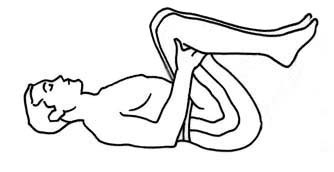
- Sit on your lower legs, bend and, stretching out your arms, stretch forward with not lifting off the buttocks from the heels( Figure 10).After twenty to thirty seconds, slowly return to the starting position. Do two approaches 6 times each.
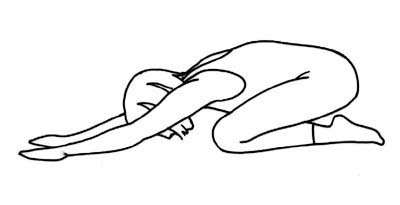
Exercises that strengthen the back muscles
- While lying on your stomach( you can put something like a cushion or cushion for comfort and creating a hill) with your hands behind your back in the coupler, lift the shoulders and top of the trunk. After being in this position for about five seconds( further increasing to 20 seconds), return to the original. Execute 8-10 times.
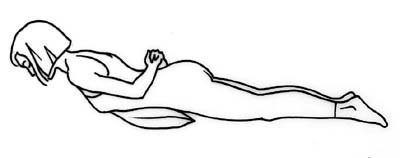
- From the position lying on the stomach( with the head and chest lowered to the floor, and the arms stretched over the head), slowly raise the hand and the opposite leg straightened in the knee by five to ten centimeters from the floor, to fix for a couple of seconds( gradually increasing to twenty)and return to its original position. Repeat from eight to ten times.

- The half-bridge. From the position on the back with the lower limbs bent in the knee joints, slowly lift the lower back and buttocks from the floor. Fix in this position for five to ten seconds, then smoothly sink. Carry out a couple of approaches with ten half-locks.
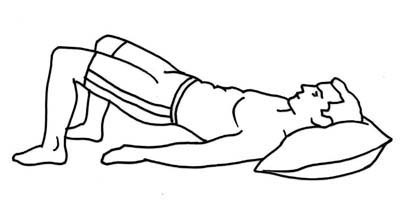
- Lie on your stomach, hands under your head. Alternately, perform lifting of the legs, slightly bent at the knees, fixing them in the upper position for five seconds. Produce eight to ten uplifts.
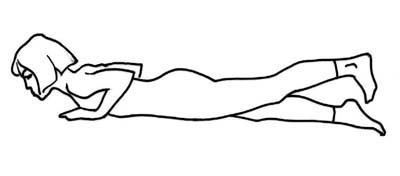
Similar exercises can be done while in a 4-point position( having the palms and knees as support points).In this case, it is necessary to avoid twisting or sagging of the trunk.
- Raise the back and up the legs alternately, slightly bent at the knees, holding it up for five seconds, then slowly lower it. Do two sets of ten lifts.

- Stand on all fours, simultaneously raise the straightened arm and the same leg from the opposite side, hold for three to five seconds. Do not forget that the back should be kept straight. Alternating arms and legs repeat eight to ten times.
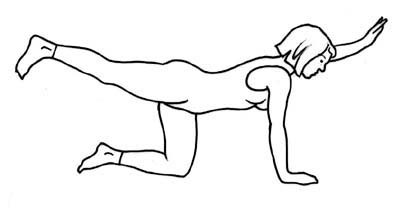
Gymnastics provides an excellent opportunity to increase flexibility and endurance, as well as strengthen certain muscle groups that maintain a neutral position of the spine. Exercise exercises should not be isolated, but be part of a wider program that is necessary to return to normal life at home and at work.
Combining gymnastics with psychological and motivational support, such as cognitive behavioral therapy, makes the patient's efforts more confident and focused.



